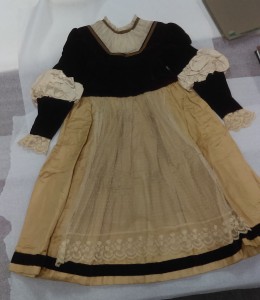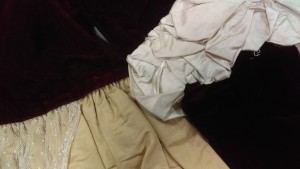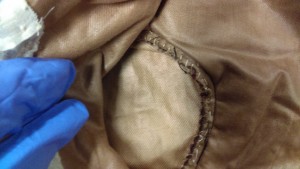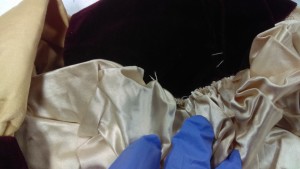Before Halloween: examining a fancy dress
By: Kristen Cnossen
While inspecting a child’s gown created between 1880 and 1885 I began to realize that there were inconsistencies in style and in the textile. It soon became obvious that this was a so-called ‘fancy dress.’ Fancy dress is similar to the contemporary concept of Halloween costume, but was worn during the Victorian-era for parties and balls, not a specific holiday.
The gown I was examining has a puffed sateen sleeve piece added just above the elbow – evidence of it being added later being the similar, yet slightly milkier, yellow color of the segment meant to match the skirt.
This along with the dotted Swiss lace added above the neckline (meant to match the lace apron and sleeve ends, but not succeeding) ending in a thin ruff collar and the dark metallic braid added along the neckline and just below the collar give what would originally have been a standard 19th century gown the appearance of being medieval.
(Although the sleeve and apron lace appear different colors, the design on both is the same. Discoloration is not uncommon in antique costumes.)
This gown was most likely older and chosen because of its square neckline, often seen in medieval gowns. The stitching appeared to be similar to the stitching found in the rest of the gown, proving that the alterations were not recent.
Fancy dresses were made, bought, or rented, as these costumes would be worn for one, perhaps two nights. The refurnishing of an old gown, like that which I was working on, would have been typical, as old gowns were frequently recycled. Hosts might ask their guests to wear thematic costumes, such as fairy tales, or France at the time of Louis XV.
The dress was donated by the wife of W.H. De Courcy Tilghman and believed to have been worn by Mrs. Charles S. Tilghman (Elizabeth Donnell).
For more on Fancy Dress:
http://blog.fidmmuseum.org/museum/fancy-dress/
http://www.victoriana.com/FancyDress/fancydresscostume.htm
https://amberbutchart.com/2012/10/26/in-the-spotlight-an-unofficial-history-of-fancy-dress/
For more on the Tilghman family:
https://www.mdhistory.org/findingaid/tilghman-family-papers-1493-1940





